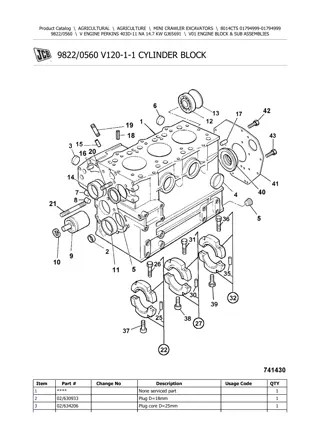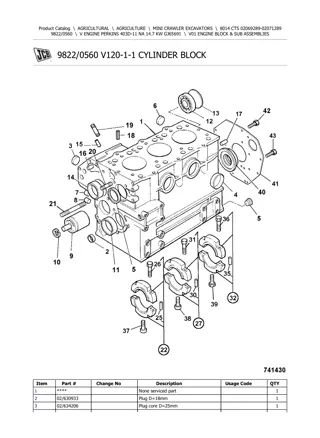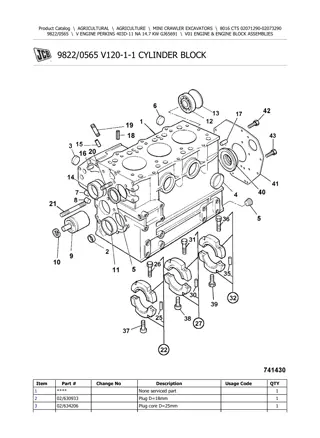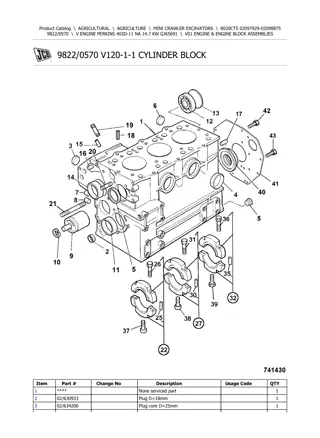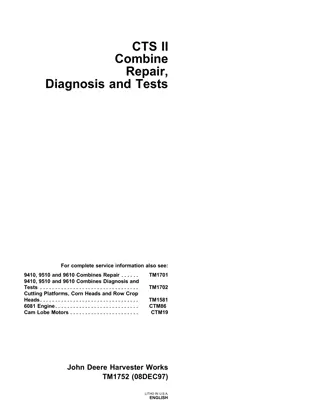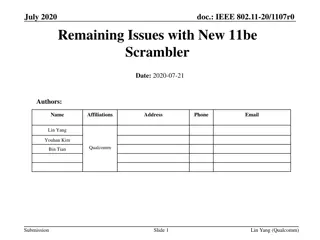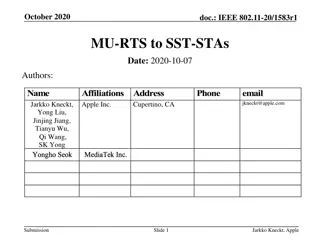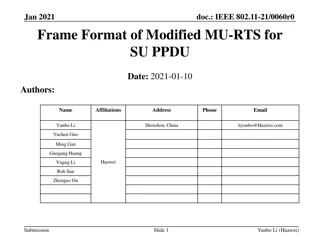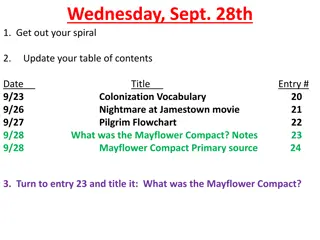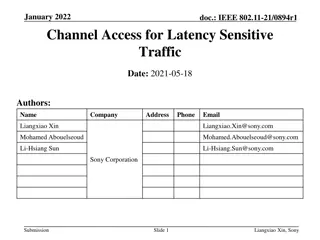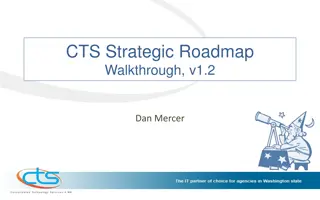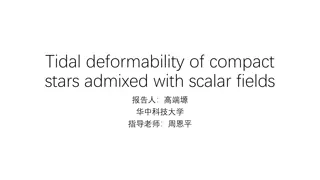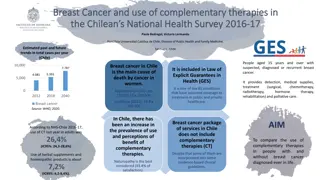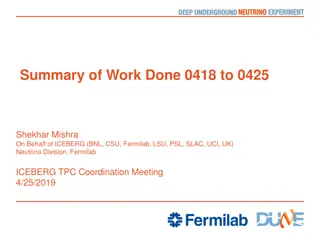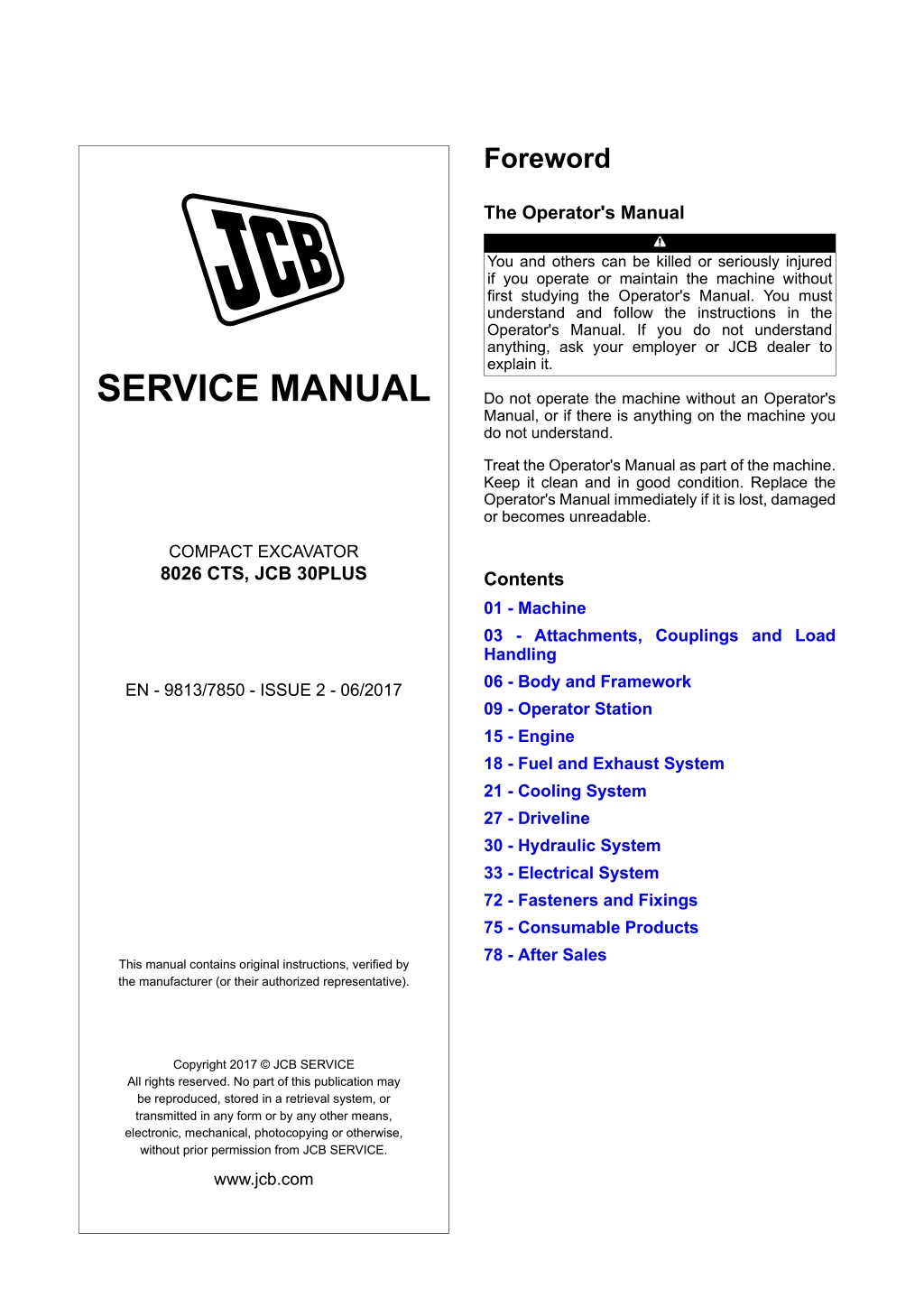
JCB 8026 CTS, JCB 30PLUS Compact Excavator Service Repair Manual Instant Download
Please open the website below to get the complete manualnn//
Download Presentation

Please find below an Image/Link to download the presentation.
The content on the website is provided AS IS for your information and personal use only. It may not be sold, licensed, or shared on other websites without obtaining consent from the author. Download presentation by click this link. If you encounter any issues during the download, it is possible that the publisher has removed the file from their server.
E N D
Presentation Transcript
Foreword The Operator's Manual You and others can be killed or seriously injured if you operate or maintain the machine without first studying the Operator's Manual. You must understand and follow the instructions in the Operator's Manual. If you do not understand anything, ask your employer or JCB dealer to explain it. SERVICE MANUAL Do not operate the machine without an Operator's Manual, or if there is anything on the machine you do not understand. Treat the Operator's Manual as part of the machine. Keep it clean and in good condition. Replace the Operator's Manual immediately if it is lost, damaged or becomes unreadable. COMPACT EXCAVATOR 8026 CTS, JCB 30PLUS Contents 01 - Machine 03 - Attachments, Couplings and Load Handling 06 - Body and Framework 09 - Operator Station 15 - Engine 18 - Fuel and Exhaust System 21 - Cooling System 27 - Driveline 30 - Hydraulic System 33 - Electrical System 72 - Fasteners and Fixings 75 - Consumable Products 78 - After Sales EN - 9813/7850 - ISSUE 2 - 06/2017 This manual contains original instructions, verified by the manufacturer (or their authorized representative). Copyright 2017 JCB SERVICE All rights reserved. No part of this publication may be reproduced, stored in a retrieval system, or transmitted in any form or by any other means, electronic, mechanical, photocopying or otherwise, without prior permission from JCB SERVICE. www.jcb.com
15 - Engine 00 - Engine 00 - General 00 - General Introduction Introduction ...................................................... 15-3 Health and Safety ........................................... 15-4 Technical Data ................................................. 15-6 Component Identification ................................. 15-7 Fault-Finding .................................................... 15-9 Drain and Fill ................................................. 15-12 Clean ............................................................. 15-13 Check (Leaks) ............................................... 15-14 Check (Pressure) .......................................... 15-15 Remove and Install ....................................... 15-16 Store and Recommission .............................. 15-17 (For: Perkins 400 Series) This section contains information about the complete engine assembly. For specific engine technical information refer to the technical data section. Make sure that the correct engine service tools, consumables and torque figures are used when you perform service procedures. Replacement of oil seals, gaskets, etc., and any component that show signs of wear or damage, is expected as a matter of course. It is expected that components will be cleaned and lubricated where required, and that any opened hose or pipe connections will be blanked to prevent excessive loss of hydraulic fluid, engine oil and ingress of dirt. Basic Description The Perkins 400 series engines are indirect injection engines. The engines are controlled with a mechanically actuated fuel injection pump. The engine cylinders are arranged in-line. The cylinder head assembly has one inlet valve and one exhaust valve for each cylinder. Each cylinder valve has a single valve spring. The crankshaft for the engine has main bearing journals. End play is controlled by the thrust washers that are located on the rear main bearing. The timing gears are stamped with timing marks in order to ensure the correct assembly of the gears. When the No. 1 piston is at top centre compression stroke, the teeth that are stamped on the crankshaft gear and the camshaft gear will be in alignment with the idler gear. The crankshaft gear turns the idler gear which then turns the camshaft gear and the gear for the engine oil pump. The fuel injection pump is mounted in the crankcase. The fuel injection pump is operated by lobes on the camshaft. The fuel transfer pump is located on the right hand side of the crankcase. The fuel transfer pump is also operated by lobes on the camshaft. The fuel injection pump conforms to requirements for emissions. If any adjustments to the fuel injection pump timing and high idle are required you must refer to a Perkins distributor or a Perkins dealer. Some fuel injection pumps have mechanical governors that control the engine rpm. Some fuel injection pumps have a governor that is electrically controlled. 15 - 3 9813/7850-2 15 - 3
15 - Engine 00 - Engine 00 - General Health and Safety A gerotor oil pump is located in the centre of the idler gear. The engine oil pump sends lubricating oil to the main oil gallery through a pressure relief valve and an engine oil filter. The rocker arms receive pressurized oil through an externally located oil line that runs from the main oil gallery to the cylinder head. Hot Components Touching hot surfaces can burn skin. The engine and machine components will be hot after the unit has been running. Allow the engine and components to cool before servicing the unit. Turning the Engine Do not try to turn the engine by pulling the fan or fan belt. This could cause injury or premature component failure. Notice: The engine and other components could be damaged by high pressure washing systems. Special precautions must be taken if the machine is to be washed using a high pressure system.Make sure that the alternator, starter motor and any other electrical components are shielded and not directly cleaned by the high pressure cleaning system. Do not aim the water jet directly at bearings, oil seals or the engine air induction system. WARNING! To bleed the injectors you must turn the engine. When the engine is turning, there are parts rotating in the engine compartment.Before starting this job make sure that you have no loose clothing (cuffs, ties etc) which could get caught in rotating parts.When the engine is turning, keep clear of rotating parts. Notice: Clean the engine before you start engine maintenance. Obey the correct procedures. Contamination of the fuel system will cause damage and possible failure of the engine. Notice: Do not exceed the correct level of engine oil in the sump. If there is too much engine oil, the excess must be drained to the correct level. An excess of engine oil could cause the engine speed to increase rapidly without control. WARNING! The engine has exposed rotating parts. Switch off the engine before working in the engine compartment. Do not use the machine with the engine cover open. WARNING! Hot oil and engine components can burn you. Make sure the engine is cool before doing this job.Used engine crankcase lubricants contain harmful contaminants. In laboratory tests it was shown that used engine oils can cause skin cancer. Notice: A drive belt that is loose can cause damage to itself and/or other engine parts. WARNING! Do not open the high pressure fuel system with the engine running. Engine operation causes high fuel pressure. High pressure fuel spray can cause serious injury or death. CAUTION! It is illegal to pollute drains, sewers or the ground. Clean up all spilt fluids and/or lubricants.Used fluids and/or lubricants, filters and contaminated materials must be disposed of in Coolant from the bottom of the radiator passes through the belt driven centrifugal cooling pump. The coolant is cooled by the radiator and the temperature is regulated by a water temperature regulator. Engine efficiency, efficiency of emission controls, and engine performance depend on adherence to correct operation and maintenance recommendations. Engine performance and efficiency also depend on the use of recommended fuels, lubrication oils, and coolants. Refer to the Maintenance Schedules (PIL 78-24). 15 - 4 9813/7850-2 15 - 4
https://www.ebooklibonline.com Hello dear friend! Thank you very much for reading. Enter the link into your browser. The full manual is available for immediate download. https://www.ebooklibonline.com
15 - Engine 00 - Engine 00 - General Technical Data Table 18. Description Engine model HL 403C-15 (Tier 2), GL 403D- 15 (Tier 3) GK 403D-15 (Tier 3) HL 403C-17 (Tier 2), GK 403D-17 (Tier 3), HL 403C-11 (Tier 2), GJ 403D-11 (Tier 3), EJ 403F-11 (T4F) Vertical in-line, 3 cylinder, nor- mally aspirated, 4 stroke, water cooled diesel. 87kg 3 GH 403D-07 (Tier 3) Type Vertical in-line, 3 cylinder, nor- mally aspirated, 4 stroke, water cooled diesel. 154kg 3 Vertical in-line, 3 cylinder, nor- mally aspirated, 4 stroke, water cooled diesel. 154kg 3 Vertical in-line, 3 cylinder, nor- mally aspirated, 4 stroke, water cooled diesel. 160kg 3 Vertical in-line, 3 cylinder, nor- mally aspirated, 4 stroke, water cooled diesel. 71kg 3 Weight (dry) Number of cylin- ders Nominal bore size Stroke Combustion Cy- cle Firing order Compression ra- tio Swept volume Valve clearance (cold) Idling speed 88mm 88mm 88mm 77mm 67mm 90mm 4-stroke 90mm 4-stroke 100mm 4-stroke 81mm 4-stroke 72mm 4-stroke 1-2-3 22.5:1 1-2-3 22.5:1 1-2-3 23:1 1-2-3 23:1 1-2-3 23.5:1 1496 cm 0.2mm 1496 cm 0.2mm 1663 cm 0.2mm 1131 cm 0.2mm 762 cm 0.2mm 1050 RPM (Rev- olutions Per Minute) 2420 RPM 1050 RPM 1050 RPM 1325 RPM Maximum no- load speed Compression pressure 2250 RPM 2592 RPM 2450 RPM 29.4bar (426.1psi) at 250 RPM 20.9kW at 2200 RPM 29.4bar (426.1psi) at 250 RPM 18.4kW at 2100 RPM 29.4bar (426.1psi) at 250 RPM 29.4kW at 2400 RPM Power output 13.7kW at 2200 RPM (Tier 2), 14.6kW at 2200 RPM (Tier 3), 14.4kW at 2200 RPM (T4F) 12.2kW at 2800 RPM 15 - 6 9813/7850-2 15 - 6
15 - Engine 00 - Engine 00 - General Component Identification (For: Perkins 400 Series) External The following identifies the main components of a typical engine assembly visible from the exterior. Some variants may differ in detail. Figure 75. Front and right side view B C A M D L E K F J H G A Fuel shutoff solenoid C Water pump E Throttle lever G Engine oil level gauge J Engine oil filter L Transfer pump B Number one fuel injector D Lower engine oil filler cap F Cover plate for the accessory drive H Engine oil cooler K Fuel injection pump M Fuel filter 15 - 7 9813/7850-2 15 - 7
15 - Engine 00 - Engine 00 - General Figure 76. Front and left side view Q P R N S T U V AD W X AC AB Y Z AA N Q S U W Y AA Fan drive belt AC Coolant temperature switch Top engine oil filler cap Rear Lifting eye Valve mechanism cover Water temperature regulator housing Electric starting motor Engine oil pan P R T V X Z AB Crankshaft pulley AD Cooling fan Crankcase breather Air inlet elbow Turbocharger Starting motor solenoid Alternator Engine oil drain plug 15 - 8 9813/7850-2 15 - 8
15 - Engine 00 - Engine 00 - General Drain and Fill Figure 77. (For: Perkins 400 Series) Oil Oil is toxic. If you swallow any oil, do not induce vomiting, seek medical advice. Used engine oil contains harmful contaminants which can cause skin cancer. Do not handle used engine oil more than necessary. Always use barrier cream or wear gloves to prevent skin contact. Wash skin contaminated with oil thoroughly in warm soapy water. Do not use petrol, diesel fuel or paraffin to clean your skin. WARNING! Hot oil and engine components can burn you. Make sure the engine is cool before doing this job.Used engine crankcase lubricants contain harmful contaminants. In laboratory tests it was shown that used engine oils can cause skin cancer. CAUTION! Keep your face away from the drain hole when removing the drain plug. CAUTION! The oil filter canister will contain some oil which could spill out when you remove the canister. CAUTION! Oil will gush from the hole when the drain plug is removed. Keep to one side when you remove the plug. C D B E A A Drain plug B O-ring C Filter mounting face D Seal E Filter canister Fill Drain 1. Clean and install the drain plug with a new O-ring. Engine oil replacement must be completed in accordance with the service schedules. Failure to replace the oil replacement at the recommended interval could cause serious engine failure. 2. Tighten the plug to the correct torque value. 3. Through one of the filler points, fill the engine with the recommended oil to the MAX mark on the dipstick. The oil must be added slowly. Drain the oil when the engine is warm as contaminants held in suspension will then be drained with the oil. 4. Wipe off any spilt oil. 5. Apply a thin layer of oil around the seal on the filter canister. 1. Make the machine safe. Refer to (PIL 01-03). 2. Get access to the engine. 6. Install the filler canister. Tighten the filter canister with hand then an additional one quarter turn. 3. Place a container of suitable size beneath the drain plug. 7. Install the filter cap. 4. Remove the filter cap. 8. Operate the engine, until the oil pressure low warning light has extinguished. 5. Remove the oil filler canister. If necessary use a chain or strap wrench. 9. Check for oil leakage. 6. Remove the oil dipstick. 10. When the oil has cooled, check the oil level again, and if necessary top up with clean engine oil. 7. Put a suitable container beneath the drain plug. 8. Remove the oil sump drain plug and O-ring from both sides of the oil sump. Table 30. Torque Values Item A Description Drain plug Nm 35 9. Drain the engine oil. 15 - 12 9813/7850-2 15 - 12
15 - Engine 00 - Engine 00 - General Clean 9. When the pressure washing is complete, move the machine away from the wash area, or alternatively, clean away the material washed from the machine. Notice: Clean the engine before you start engine maintenance. Obey the correct procedures. Contamination of the fuel system will cause damage and possible failure of the engine. Notice: The engine and other components could be damaged by high pressure washing systems. Special precautions must be taken if the machine is to be washed using a high pressure system. Make sure that the alternator, starter motor and any other electrical components are shielded and not directly cleaned by the high pressure cleaning system. Do not aim the water jet directly at bearings, oil seals or the engine air induction system. 10. Before working on specific areas of the engine, use a compressed air jet to dry off any moisture. When the area is dry, use a soft clean brush to remove any sand or grit particles that remain. 11. When removing components, be aware of any dirt or debris that may be exposed. Cover any open ports and clean away the deposits before proceeding. Additional cleaning must be carried out prior to working on the high pressure fuel system. Refer to Fuel System, General, Clean (PIL 18-00). Before carrying out any service procedures that require components to be removed, the engine must be properly cleaned. Cleaning must be carried out either in the area of components to be removed or, in the case of major work, or work on the fuel system, the whole engine and surrounding machine must be cleaned. Stop the engine and allow it to cool for at least one hour. DO NOT attempt to clean any part of the engine while it is running. 1. Make sure that the electrical system is isolated. 2. Make sure that all electrical connectors are correctly connected. If connectors are open install the correct caps or seal with water proof tape. 3. Cover the alternator with a plastic bag to prevent water ingress. 4. Seal the engine air intake, exhaust and breather system. 5. Make sure that the oil filler caps and dipstick are correctly installed. 6. Use a low pressure water jet and brush to soak off mud or dirt. 7. Apply an approved cleaning and degreasing agent with a brush. Obey the manufacturers instructions. 8. Use a pressure washer to remove the soft dirt and oil. Important: DO NOT aim the water jet directly at oil seals or electrical and electronic components such as the engine electronic control unit (ECU), alternator or fuel injectors. DO NOT place the jet nozzle closer than 600mm (24in) to any part of the engine. 15 - 13 9813/7850-2 15 - 13
15 - Engine 00 - Engine 00 - General Check (Leaks) 8. Inspect the fuel system for leaks. Look for loose fuel line clamps and/or tie-wraps. Refer to (PIL 18-00). (For: Perkins 400 Series) 9. Inspect the piping for the air intake system and the elbows for cracks and for loose clamps. Refer to (PIL 15-24). The walk-around inspections should be performed before starting the machine. It can help to prevent machine damage and ensure your safety. A walk- around inspection should only take a few minutes. When the time is taken to perform these checks, costly repairs and accidents can be avoided. 10. Make sure that the hoses and the tubes are not contacting other hoses, tubes, wiring harnesses, etc. 11. Inspect the engine drive belt for cracks, breaks or other damage. Refer to (PIL 15-18). Inspect the engine for leaks and for loose connections: 11.1. For applications that require multiple drive belts, replace the belts in matched sets. Replacing only one belt of a matched set will cause the new belt to carry more load because the older belt is stretched. The additional load on the new belt could cause the new belt to break. 1. Do a thorough inspection of the engine compartment before starting the engine. 2. Look for the following items and do the repair as necessary. 2.1. Oil leaks. 12. Drain the water and the sediment from the fuel tank on a daily basis in order to make sure that only clean fuel enters the fuel system. 2.2. Coolant leaks. 2.3. Loose bolts. 2.4. Worn belts. 13. Inspect the wiring and the wiring harnesses for loose connections and for worn wires or frayed wires. Refer to (PIL 33-12). 2.5. Loose connections. 2.6. Build up of dirt. 14. Inspect the ground/earth strap for a good connection and for good condition. 3. Make sure that the guards are in the correct place. Repair the damaged guards or replace the missing guards, if any. 15. Disconnect any battery chargers that are not protected against the current drain of the starter motor. Check the condition and the electrolyte level of the batteries, unless the engine is equipped with a maintenance free battery. Refer to (PIL 33-03). 4. Wipe all the caps and the plugs before the engine is serviced to reduce the chances of system contamination. 4.1. If any leaks are found, clean up the fluid. 16. Check the condition of the gauges. Replace any gauges that are cracked. Replace any gauge that cannot be calibrated. 4.2. Find the source and correct the leak. 4.3. If leaking is suspected, check the fluid levels more often than recommended until the leak is found or fixed, or until the suspicion of a leak is proved to be unwarranted. 4.4. Make a note that accumulated grease and/ or oil on an engine is a fire hazard. Remove the accumulated grease and oil. 5. Make sure that the cooling system hoses are correctly clamped and the cooling system hoses are tight. Check for leaks. Check the condition of all pipes. Refer to (PIL 21-00). 6. Inspect the cooling pump for coolant leaks. Refer to (PIL 21-09). 7. Inspect the lubrication system for leaks at the front oil seal, the rear oil seal, the oil sump, the oil filters and the rocker cover. 15 - 14 9813/7850-2 15 - 14
15 - Engine 00 - Engine 00 - General Check (Pressure) Table 31. - Standard at assembly 29.4bar (426.1psi) Repair limit (For: Perkins 400 Series) Compression pressure (1) The compression pressure is taken at 250 RPM. 24.5bar (355.1psi) (1) Special Tools Description Pressure Gauge (0-40 Bar) Digital Hydraulic Pressure Test Kit Part No. 892/00278 Qty. 1 Oil Pressure Test 998/11051 1 Important: You must use a suitable pressure gauge that measures the oil pressure in the engine. An oil pressure gauge that has a defect can indicate low oil pressure. Compression test Important: Compression tests should only be used to compare pressures between cylinders of an engine. If one or more cylinders vary more than 3.5bar (50.7psi) then those cylinders may be damaged. The cylinder compression test should not be the only test for determining the condition of an engine. 1. Make sure that the engine is filled to the correct oil level. 2. Connect the pressure gauge to a pressure test point location for engine oil. Special Tool: Digital Hydraulic Pressure Test Kit (Qty.: 1) Special Tool: Pressure Gauge (0-40 Bar) (Qty.: 1) The following conditions can affect the result of the cylinder compression test, make sure you check the following points before starting the test: 3. Start the engine. Allow the engine to obtain normal operating temperature. The battery is in good condition. The battery is fully charged. The starter motor operates correctly. The valve lash adjustment is set correctly. The compression gauge is accurate. 4. Keep the oil temperature constant with the engine at the rated RPM. Read the pressure gauge. 5. Check the engine oil pressure is correct. Refer to Table 32. 1. Remove the fuel injector from the cylinder to measure the compression for that cylinder. Table 32. 2. Connect a suitable compression gauge to the cylinder. (1) Oil Pressure Oil pressure at high idle 1.96 4.41bar (28.4 63.9psi) 0.49bar (7.1psi) 3. Disconnect Solenoid). the ESOS (Engine Shut-Off Oil pressure at low idle (1) The 011 temperature must be 80 110 C (175.9 229.8 F) 4. Operate the starter motor and record the pressure on the compression gauge. 5. Repeat step 1 to step 4 for each cylinder. 6. Repair the engine if the compression is lower than the repair limit. Refer to Table 31. Important: Make sure that you measure the compression on all of the cylinders. If all of the cylinders are not checked an improper diagnosis may result. The compression pressure will vary with the change in engine RPM (Revolutions Per Minute). It is necessary to keep the engine RPM constant for all cylinders when you are taking a compression reading. 15 - 15 9813/7850-2 15 - 15
15 - Engine 00 - Engine 00 - General Remove and Install 11. Disconnect the wiring connections from the engine sensors and actuators. Refer to (PIL 15-84). (For: Perkins 400 Series) 12. Disconnect the fuel supply line at the fuel lift pump and the spill line at the fuel injection pump. Cap all hoses and ports to prevent ingress of dirt. The lifting equipment used must be an approved type and capable of lifting the engine safely. The recommended lifting equipment is shown. Use a spreader bar when lifting the engine. Never attempt to manually lift heavy components on your own. Always use lifting equipment, or obtain the help of an assistant. Inspect the lifting brackets for signs of damage. The brackets must be correctly torqued to the crankcase. Make sure the lifting equipment does not damage any of the engine dressing and the rocker cover. 13. Disconnect the electrical harness at the engine harness. 14. Uncouple ECM (Engine Control Module) machine side connector. Important: DO NOT touch the connector pins on the ECM or harness connectors. Cover the connectors to prevent contamination. the electrical harness at the 15. Ensure that all relevant harnesses and hoses are unclipped from the engine and tied out of the way. There will be some component differences depending on the machine variant. Before attempting to remove the engine ensure that all the necessary components have either been removed, or safely disconnected from the engine. 16. Disconnect and plug the hoses at the hydraulic pump. 17. Disconnect the wiring to the hydraulic pump. Before Removal 18. Attach slings to the engine lifting eyes. 1. Make sure that the engine is safe to work on. If the engine has been running, let it cool before you start the service work. Figure 78. 2. Make the machine safe. Refer to (PIL 01-03). 3. Get access to the engine. Remove 1. Disconnect and remove the battery. Refer to (PIL 33-03). 2. Drain the engine oil. Refer to (PIL 15-21). A B 3. Drain the engine coolant and remove the cooling pack. Refer to (PIL 21-03). 4. Discharge the hydraulic pressure. Refer to (PIL 30-00). C 5. Drain the hydraulic tank. Disconnect and plug the hydraulic pipes. Label the hoses to ensure correct reassembly. 6. Disconnect and plug the hydraulic cooler hoses. Label the hoses to ensure correct reassembly. 7. Disconnect the exhaust system. A Engine B Sling C Lifting eye 8. Label the cab heater hoses at the engine crankcase. Release the hose clips and remove the hoses. 19. Take the weight of the engine on the hoist and remove the engine mounting bolts. 9. Disconnect the wiring connections from the starter motor. Refer to (PIL 15-75). 20. Withdraw the engine in a level attitude until it is clear of the chassis. Raise the engine to lift it clear of the machine. 10. Disconnect the wiring connections from the alternator. Refer to (PIL 15-72). 15 - 16 9813/7850-2 15 - 16
15 - Engine 00 - Engine 00 - General Store and Recommission 21. Lower the engine into a suitable stand that is capable of supporting the weight of the engine. Install (For: Perkins 400 Series) Consumables Description Cleaner/Degreaser - General purpose solvent based parts cleaner 1. The installation procedure is the opposite of the removal procedure. Additionally do the following steps. Part No. 4104/1557 Size 0.4L 2. Fill the cooling system with the correct mix of coolant fluid. Refer to (PIL 21-00). 3. Fill and Check the hydraulic fluid level. Refer to (PIL 30-00). If the engine is not started for several weeks, the lubricating oil will drain from the cylinder walls and from the piston rings. This forms the rust on the cylinder walls. The rust on the cylinder walls will cause increased engine wear and a reduction in engine service life. 4. Fill and Check the engine oil level. Refer to (PIL 15-00). 5. On completion, check hydraulic and cooling system for leakage and levels. If an engine is out of operation and if use of the engine is not planned, special precautions should be made. If the engine is stored for more than one month, a complete protection procedure is recommended. 6. Check the function of drive and excavator services. Table 33. Torque Values Item C Nm 25 When you protect the engine in accordance with the following procedure, it makes sure that no corrosion will occur. 1. Before you store the engine make sure that: 1.1. The environment is not humid or exposed to bad weather. 1.2. The storage place is not near an electric panel. 1.3. Prevent storing the engine in direct contact with the ground. Lubrication System 1. Drain the fuel system completely and refill the system with preservative fuel. 1.1. The "1772204 POWERPART Lay-Up 1" can be mixed with the normal fuel in order to change the fuel into preservative fuel. 1.2. If preservative fuel is not available, the fuel system can be filled with normal fuel. This fuel must be discarded at the end of the storage period together with the fuel filter elements. 2. Operate the engine until the engine reaches the normal operating temperature. 3. Stop any leaks from fuel, lubricating oil or air systems. 4. Stop the engine and drain the lubricating oil from the oil sump. 15 - 17 9813/7850-2 15 - 17
15 - Engine 00 - Engine 00 - General 5. Replace the lubricating oil filter. 10. Close the tap or connect the radiator hose. 6. Fill the oil sump to the Full Mark on the engine oil level gauge with new, clean lubricating oil. 11. Fill the cooling system with an approved antifreeze mixture because this gives protection against corrosion. Certain corrosion inhibitors could cause damage components. Contact your JCB dealer for details. 6.1. Add "1762811 POWERPART Lay-Up 2" to the oil in order to protect the engine against corrosion. to some engine 12. Operate the engine for a short period to circulate the coolant in the engine. 6.2. If "1762811 POWERPART Lay-Up 2" is not available, use a preservative of the correct specification instead of the lubricating oil. 13. Disconnect the battery. Refer to (PIL 33-03). 6.3. If a preservative is used, this must be drained completely at the end of the storage period and the oil sump must be refilled to the correct level with normal lubricating oil. 14. Apply the "1734115 POWERPART Lay-Up 3" to protect the battery terminal from corrosion. 15. Put the battery into safe storage in a fully charged condition. Cooling System 16. If installed, clean the crankcase breather and seal the end of the pipe. 1. Make the machine safe. Refer to (PIL 01-03). 17. Remove the fuel injectors and spray "1762811 POWERPART Lay-Up 2" for specified duration into each cylinder bore with the piston at BDC (Bottom Dead Centre). 2. Remove the filler cap of the cooling system. 3. Remove the drain plug from the side of the crankcase. Figure 79. 18. Slowly rotate the crankshaft for one complete revolution and then install the fuel injectors. Induction System 1. Remove the air filter assembly. 2. If necessary, remove the fuel pipes that are installed between the air filter assembly and the turbocharger. 3. Spray "1762811 POWERPART Lay-Up 2" into the turbocharger. The duration of the spray is printed on the container. A 4. Seal the turbocharger with waterproof tape. Exhaust System 1. Remove the exhaust pipe. 2. Spray "1762811 POWERPART Lay-Up 2" into the turbocharger. The duration of the spray is printed on the container. A Drain plug 4. Make sure that the drain hole is not restricted. 5. Drain the engine. 3. Seal the turbocharger with waterproof tape. 6. Open the tap or remove the drain plug at the bottom of the radiator. If the radiator does not have a tap or a drain plug, disconnect the hose at the bottom of the radiator. General Items 1. If the lubricating oil filler is installed on the valve mechanism cover, remove the filler cap. 7. Drain the radiator. 2. If the lubricating oil filler cap is not installed on the valve mechanism cover, remove the valve mechanism cover. 8. Flush the cooling system with clean water. 9. Fit the drain plugs and the filler cap. 3. Spray "1762811 POWERPART Lay-Up 2" around the rocker shaft assembly. 15 - 18 9813/7850-2 15 - 18
15 - Engine 00 - Engine 00 - General 4. Install the filler cap or the valve mechanism cover. 5. Seal the vent of the fuel tank or the fuel filler cap with waterproof tape. 6. Remove the alternator drive belts and put the drive belts into storage. 7. In order to prevent corrosion, spray the engine with "1734115 POWERPART Lay-Up 3". Do not spray the area inside the alternator. Engine Starting After Storage 1. Remove the protective sheet. 2. Use a cloth soaked in degreasing fluid to remove the protective treatment from the external parts. Consumable: Cleaner/Degreaser - General purpose solvent based parts cleaner 3. Inject lubricating oil (not more than 2cm ) into the intake ducts. 4. Adjust the alternator belt tension. Refer to (PIL 15-18). 5. Refuel the machine. 6. Make sure that the oil and the coolant are up to the maximum level. 7. Start the engine and run at idle speed for the specified duration. Duration: 2min 8. Bring the engine to 75% of the maximum rated speed for the specified duration. Duration: 5 10min 9. Stop the engine. 10. While the oil is still hot, drain the protective oil into a suitable container. 11. Put new oil up to the maximum level. 12. Replace the filters (air, oil and fuel). 13. Drain the cooling system completely and put new coolant up to the maximum level. Refer to (PIL 21-00). Important: Over an amount of time, lubricants and filters lose their properties, so it is important to consider whether they need replacing, also based on the criteria mentioned in the maintenance schedules. If the engine is not to be used for an extended period, the protective treatment procedure must be repeated within 730d of the previous one. 15 - 19 9813/7850-2 15 - 19
15 - Engine 03 - Crankcase 00 - General 00 - General Introduction Introduction .................................................... 15-21 Technical Data ............................................... 15-22 Check (Condition) .......................................... 15-22 The crankcase is the housing for the crankshaft. The enclosure forms the largest cavity in the engine and is located below the cylinders. It is integral with the cylinder bank and forms an engine block. It has an opening in the bottom to which an oil sump is attached with a gasket and bolted joint. The crankcase protects the crankshaft and connecting rods from foreign objects it also keeps the engine oil contained and allows the oil to be pressurised and also provide the rigid structure with which to join the engine to the transmission. Figure 80. B A A Crankcase B Crankshaft 15 - 21 9813/7850-2 15 - 21
15 - Engine 03 - Crankcase 00 - General Technical Data Check (Condition) (For: Perkins 400 Series) (For: Perkins 400 Series) 1. Check the six positions for flatness with a straight edge and the feeler gauge. Refer to Figure 82. Table 34. Cylinder bore data Description Diameter of bore Bore service limit Flatness of the top of the cylinder Service limit for the flat- ness Clearance between the tappet and the tappet bore (Maximum) Clearance between the tappet and the tappet bore (Service limit) Data 84 84.019mm 84.2mm Less than 0.05mm Figure 82. B A 0.12mm 0.058mm C 0.08mm 1 4 Figure 81. 3 6 5 2 A Crankcase B Straight edge C Feeler gauge 2. Inspect the top of the crankcase for cracks, damage and warping. A B 3. Inspect each cylinder bore. 3.1. Make sure that there are no signs of scoring or corrosion. A Tappet B Tappet bore 3.2. Measure each cylinder bore with a suitable gauge. 3.3. Measure the area of each cylinder bore that is in contact with the top, middle and bottom piston rings. 3.4. Make sure that you measure each cylinder bore at right angles to the crankshaft. 3.5. Do NOT use the flex-hone process on this engine. 4. Make sure that the cylinder bore dimensions do not exceed the specified service limits. Refer to Technical data (PIL 15-03). 5. If the service limit for the crankcase is exceeded, you must replace the crankcase. 15 - 22 9813/7850-2 15 - 22
15 - Engine 06 - Cylinder Head 00 - General Technical Data Check (Condition) (For: Perkins 400 Series) (For: Perkins 400 Series) 1. Make the machine safe. Refer to (PIL 01-03). Table 35. Cylinder head gasket Piston height below top face of crankcase +0.35mm to +0.5mm +0.5mm to +0.6mm Gasket Thickness 2. Get access to the engine. Refer to (PIL 06-06). 3. Remove the cylinder head bolts in the reverse numerical order. This will prevent distortion of the cylinder head. Refer to Figure 83. 1.2mm 1.3mm Table 36. Distortion of the cylinder head Figure 83. Description Distortion of the cylinder head Maximum service limit Maximum limit for re- grinding the cylinder head Data 0 0.05mm 12 4 5 13 8 1 9 17 16 0.12mm 0.15mm 7 2 10 18 15 11 3 6 14 4. Remove the cylinder head from the engine. 5. Clean the cylinder head thoroughly. 6. Make sure that the contact surface of the cylinder head and the contact surface of the crankcase are clean, smooth and flat. 7. Inspect the bottom surface of the cylinder head for pitting, corrosion and cracks. 8. Inspect the area around the valve seats and the holes for the fuel injectors. 9. Put the cylinder head on a suitable support. Figure 84. A B A Cylinder head B Support 10. Use a straight edge and a feeler gauge to check the six positions for distortion. Refer to Figure 85. 15 - 28 9813/7850-2 15 - 28
15 - Engine 06 - Cylinder Head 00 - General Calibrate Figure 85. 1 (For: Perkins 400 Series) The dowel pins in the crankcase hold the cylinder head gasket in the correct position when the cylinder head is installed. Refer to Figure 86. The stamped marking on the cylinder head gasket must face upward. This makes sure that the cylinder head gasket is installed correctly. Refer to Figure 86. 4 3 5 6 2 Figure 86. A B C A Dowel pins B Gasket C Stamped marking Before you tighten the bolts, apply clean engine oil on the threads of the bolts. The bolts must be tightened to the torque of 101N m in the specified numerical sequence only. Refer to Figure 87. Figure 87. 12 4 5 13 8 1 9 17 16 7 2 10 18 15 11 3 6 14 Use a straight edge and a feeler gauge to check the six positions for distortion. Refer to Figure 88. Figure 88. 1 4 3 5 6 2 15 - 29 9813/7850-2 15 - 29
15 - Engine 06 - Cylinder Head 00 - General Remove and Install If you grind the cylinder head, check the valve depth below the cylinder head face. Refer to (PIL 15-30). (For: Perkins 400 Series) CAUTION This component is heavy. It must only be removed or handled using a suitable lifting method and device. Remove 1. Make the machine safe. Refer to (PIL 01-03). 2. Make sure that the engine is safe to work on. If the engine has been running, let it cool before you start the service work. 3. Remove the exhaust manifold. Refer to (PIL 18-24). 4. Remove the fuel filter. Refer to (PIL 18-09). 5. Remove the fuel injectors. Refer to (PIL 18-18). 6. Remove the glow plugs. Refer to (PIL 15-80). 7. Remove the rocker shaft and the push rods. Refer to (PIL 15-42). 8. Remove the cooling pump. Refer to (PIL 21-09). 9. Drain the cooling system. Refer to (PIL 21-00). 10. Gradually loosen the bolts in reverse numerical order. This will prevent distortion of the cylinder head. Refer to Figure 89. Figure 89. 12 4 5 13 8 1 9 17 16 7 2 10 18 15 11 3 6 14 11. Remove the bolts from the cylinder head. 12. Carefully lift the cylinder head off the crankcase with a suitable lifting device. 13. Make sure of the following: 13.1. Do not use a lever to separate the cylinder head from the crankcase. 13.2. Take care not to damage the machined surfaces of the cylinder head. 13.3. Avoid contamination of the cylinder bores with coolant or with debris. 15 - 30 9813/7850-2 15 - 30
Suggest: If the above button click is invalid. Please download this document first, and then click the above link to download the complete manual. Thank you so much for reading
15 - Engine 06 - Cylinder Head 00 - General 13.4. Place the cylinder head on a surface that will not scratch the face of the cylinder head. head is distorted beyond the maximum permitted limits, replace the cylinder head. 4. Inspect dowels for damage. If necessary, replace the dowels in the crankcase. 14. Remove the cylinder head gasket. Retain the old gasket to help identification. 5. Install the guide bolts to the crankcase. 15. Make a note of the position of the dowels. Do not remove the dowels unless they are damaged. 6. Make sure that the new gasket is of the same thickness as the old gasket. 16. If necessary, remove the thermostat from the cylinder head. Refer to (PIL 21-12). 7. Align the gasket with the guide bolt and the dowels. Install the gasket onto the crankcase. Figure 90. 8. Lift the cylinder head with a suitable lifting device. A 9. Align the cylinder head with the guide bolts on the crankcase. Install the cylinder head onto the crankcase. 10. Make sure that the cylinder head is correctly positioned on the dowels. 11. Remove the guide bolts. 12. Install the bolts to the cylinder head. 13. Tighten the bolts to the correct torque value in the specified numerical sequence only. Refer to Figure 89. B 14. If removed, install the thermostat to the cylinder head. Refer to (PIL 21-12). A Bolt B Cylinder head 15. Install the cooling pump. Refer to (PIL 21-09). 16. Install the rocker shaft and the push rods. Refer to (PIL 15-42). Figure 91. D 17. Install the glow plugs. Refer to (PIL 15-80). C D 18. Install the fuel injectors. Refer to (PIL 18-18). C 19. Install the fuel filter. Refer to (PIL 18-09). 20. Install the exhaust manifold. Refer to (PIL 18-24). Table 37. Torque Values Item A Description Bolt Nm 100 C Dowel D Guide bolt (M11 by 100mm) Install 1. Clean the mating surfaces of the cylinder head and the crankcase. 2. Make sure that no debris enters the cylinder bores, the coolant passages, or the lubricant passages. 3. Inspect the mating surface of the cylinder head for distortion. If the mating surface of the cylinder 15 - 31 9813/7850-2 15 - 31
https://www.ebooklibonline.com Hello dear friend! Thank you very much for reading. Enter the link into your browser. The full manual is available for immediate download. https://www.ebooklibonline.com



